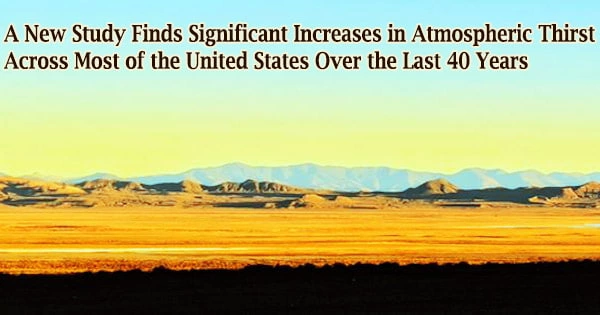The climate in the Western states is becoming warmer and dryer, putting additional pressure on water supplies from humans and ecosystems.
According to a new study by a team from DRI, the University of California, Merced, and the Scripps Institution of Oceanography at UC San Diego, the atmosphere across most of the United States is now demanding a higher proportion of water than it used to.
The study, which was published in the Journal of Hydrometeorology, used five datasets to examine patterns in evaporative demand across the United States over a 40-year period from 1980 to 2020.
Evaporative demand, often known as “atmospheric thirst,” is a calculation of the amount of water that could be lost from the earth’s surface to the atmosphere based on temperature, humidity, wind speed, and solar radiation.
The researchers discovered significant increases in atmospheric thirst across most of the Western United States during the last 40 years, with the highest and most pronounced increases in an area concentrated on the Rio Grande and Lower Colorado rivers.
These areas have undergone shifts of two to three standard deviations during the baseline period of 1980-2000.
This study shows the dominant role that warming has played on the increasing evaporative demand and foreshadows the increased water stressors the West faces with continued warming.
John Abatzoglou
“This means that atmospheric thirst conditions in parts of the country are now verging outside of the range that was experienced 20 to 40 years ago, especially in some regions of the Southwest,” said lead author Christine Albano, Ph.D., of DRI.
“This is really important to understand, because we know that atmospheric thirst is a persistent force in pushing Western landscapes and water supplies toward drought.”
Albano and her colleagues studied the relative influences of temperature, wind speed, solar radiation, and humidity on air thirst to learn more about the role that different climate factors have in determining atmospheric thirst.
Temperature increases accounted for 57 percent of the changes seen across all regions, with humidity (26 percent), wind speed (10 percent), and sun radiation (8 percent) playing smaller impacts.
“This study shows the dominant role that warming has played on the increasing evaporative demand and foreshadows the increased water stressors the West faces with continued warming,” said study co-author John Abatzoglou, Ph.D., of the University of California, Merced.
Increases in atmospheric thirst indicate that more water will be needed in the future to meet present water needs for farmers and other water users. Some of the changes identified in this study are concentrated in places where rising temperatures and lower-than-average precipitation are already putting a strain on water supplies.
The study authors calculated that atmospheric thirst increased by 8 to 15% in the Rio Grande region between 1980 and 2020. If everything else stays the same, and no other management adjustments are made, this means that 8 to 15% more water is needed to sustain the same well-watered crop.
“Our analysis suggests that crops now require more water than they did in the past and can be expected to require more water in the future,” said study co-author Justin Huntington, Ph.D., of DRI.
Drought, increased forest fire area, and reduced stream flows are some of the other effects of increased atmospheric hunger.
“Our results indicate that, decade by decade, for every drop of precipitation that falls, less and less water is likely to drain into streams, wetlands, aquifers, or other water bodies,” said study co-author Michael Dettinger, Ph.D., of Scripps Institution of Oceanography and DRI.
“Resource managers, policy makers, and the public need to be aware of these changes and plan for these impacts now and into the future.”
Members of the team are now working on seasonal and sub-seasonal evaporative demand estimates.
“We anticipate these types of forecasts will be important for drought and fire forecasting applications,” said study co-author Dan McEvoy, Ph.D., of DRI.





